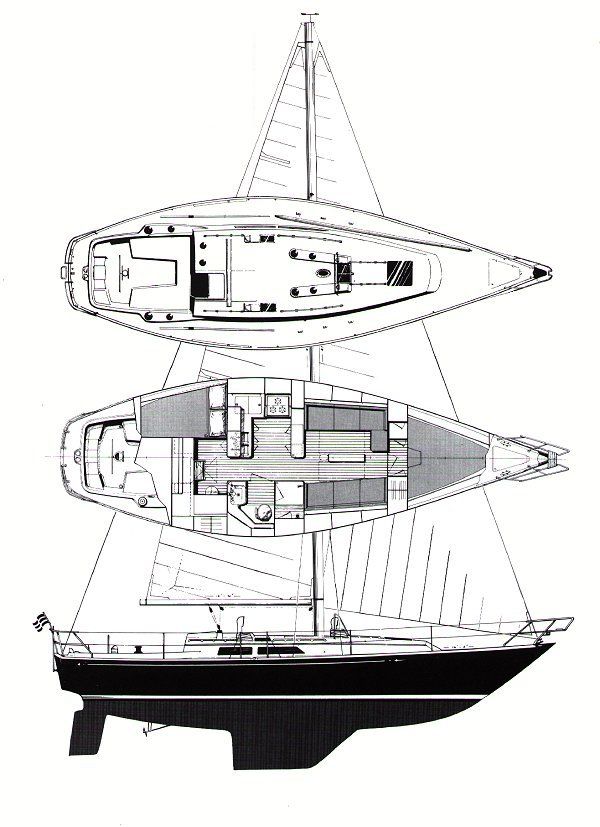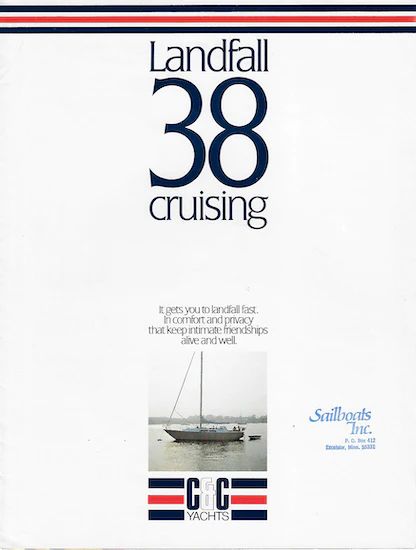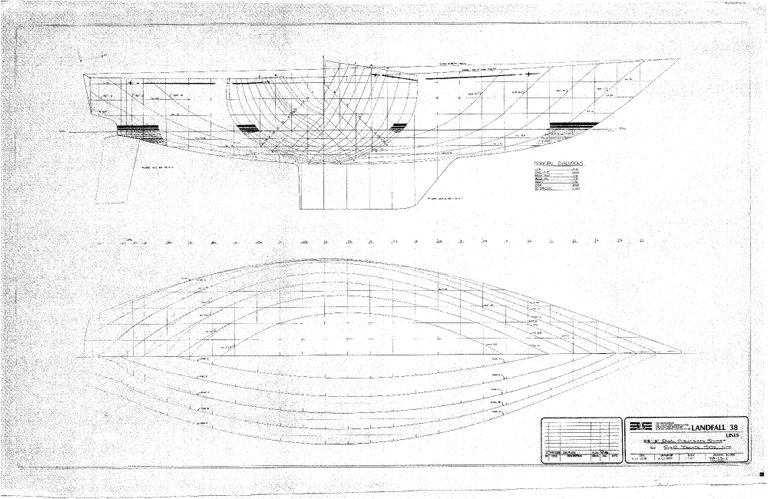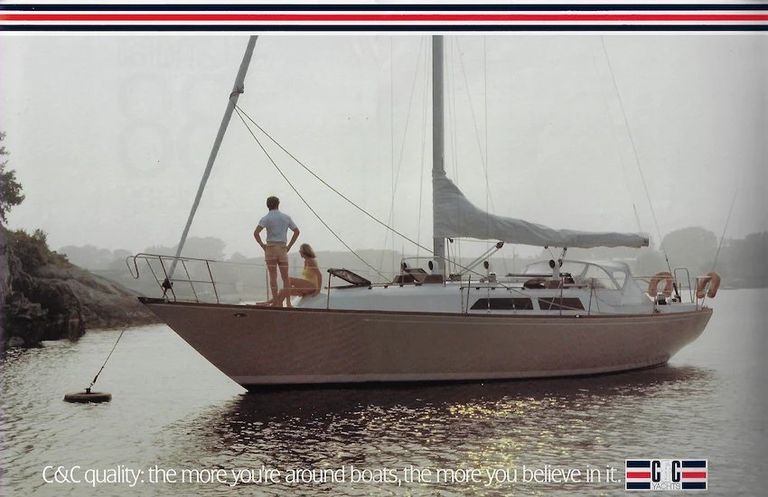



C&C 38 Landfall
LOA: 37' 7"" LWL: 30' 2"
Yacht Names
Echo Beach,
Bold Response,
Water Lillie
DWG #
78-13
2008.0012.0038 (1-2)
2008.0012.0055. (1-26 )
2008.0012.0108 (1),
2008.0012.0156.0004,
2010.0010.0574,
2012.0010.0019.(1-2)
Designer / Draughtsman
C&C Design Group
Year of Design
1978
Builder
C&C Yachts Limited
Boat Brochure
https://boatbrochure.com/products/c-c-landfall-38-brochure-1?_pos=2&_sid=4ccce72e8&_ss=r
Notes
Design
The C&C 38 series are all a small recreational keelboats, built predominantly of fiberglass, with wood trim. They all have masthead sloop rigs and internally-mounted spade-type rudders. The series includes three designs, the C&C 38 (subsequently called the 38-1 to differentiate it from the later models), the 38-2 and the 38-3. The latter boat was an entirely new design. The 38-2 was used as the basis for the Landfall 38, built with the same hull shape, but a shorter keel and rig, plus a different interior.
C&C 38 Landfall
This model was a completely new design, introduced in 1985. It has a length overall of 37.55 ft (11.4 m), a waterline length of 31.00 ft (9.4 m), displaces 14,275 lb (6,475 kg) and carries 6,246 lb (2,833 kg) of lead ballast. The boat has a draft of 7.50 ft (2.29 m) with the standard keel, 5.00 ft (1.52 m) with the optional shoal draft keel and 5.50 ft (1.68 m) with the optional wing keel. A stub keel and centreboard version was also built, with a draft of 7.75 ft (2.36 m) with the centreboard extended and 4.92 ft (1.50 m) with it retracted.
The boat is fitted with a Japanese Yanmar YHM35F diesel engine. The fuel tank holds 20 U.S. gallons (76 L; 17 imp gal) and the fresh water tank has a capacity of 60 U.S. gallons (230 L; 50 imp gal). The standard keel boat has a PHRF racing average handicap of 105 with a high of 114 and low of 102. The wing keel version has an average handicap of 108 with a high of 111 and low of 108. The centreboard version has an average handicap of 117 with a high of 126 and low of 117. All versions have hull speeds of 7.46 kn (13.82 km/h).
https://en.wikipedia.org/wiki/C%26C_38
C&C Landfall 38
2008 October 30
By JOHN KRETSCHMER
Being too racy for its day in 1979 makes it a good cruiser today I've always liked the word landfall. It evokes the essential dream of cruising, the successful conclusion of a voyage, landfall is your payoff. C&C had high hopes when it launched its Landfall series in the late 1970s. Cruising was putting a new twist on sailboat design by blending modern materials with traditional appearance, the dream of sailing to faraway places suddenly seemed within reach and builders were scrambling to come out with cruising boats. C&C, the progressive Canadian company that dominated performance sailing, hoped to make a splash in the cruising boat market as well. Unfortunately, its Landfall boats, at least to the sailing public, never quite lived up to the evocative name. C&C's first Landfall model was a chunky, 42-foot center-cockpit model designed to compete with Morgan, Irwin, Whitby and others. It gained some popularity as a charter boat in the Caribbean but never as a private cruiser.
The Landfall 38 was launched in 1979. Although the boat was thoughtfully designed and responsibly manufactured, like its bigger sistership, it never really caught on. C&C just couldn't shed its stripes, to many the Landfall 38 looked more like a racing boat than a cruising boat. It wasn't, Neptune forbid, a double-ender. It was modern with sweet lines, a moderate draft, a fresh interior design and an efficient sailplan. By the time production wound down in 1985, just 180 Landfall 38s had been built. By comparison, Tayana, Taiwan builders of a teak-drenched, full-keeled, 37-foot cutter, was producing hull No. 500 when the Landfall 38 tools were shuffled to the back lot. But how times change. Sailboat designs like fashions seem to come back around. How else would you explain the spree of elegant daysailers currently in production? Today, the very features that didn't stack up against the Tayana 37 in the early 1980s make the Landfall 38 desirable on the used boat market. Consider most new cruising designs. They invariably feature a performance-oriented hull shape, often with shoal draft. Maintenance is kept to a minimum, especially externally. They eschew traditional and boring interior layout plans. These same criteria define the Landfall 38. Maybe it was just a boat ahead of its time. First impressions
The Landfall 38 bears the unmistakable pedigree of C&C. That is, the first incarnation of C&C, when the Canadian firm was one of the world's premier builders. At this time Rob Ball was heavily involved in the C&C design office and deserves credit for the Landfall 38. Sure the teak caprail was a departure from C&Cs near trademark aluminum toerail, but that was just a modest way of competing with Taiwanese boats. The modern profile, sleek cabintrunk, fine entry and pinched IOR stern screamed Cuthbertson and Cassian. And I confess without a hint of shame, it's a look I've always admired.
The Landfall 38 is a masthead sloop with 649 square feet of working sail. The hull shape features a lovely entry and long bow overhang that shortens the LWL to a little less than 30 feet. A moderate fin keel with a draft of 4 feet, 11 inches was standard while a 5-foot, 8-inch deep-draft keel was also available but not popular. The free-standing balanced rudder is mounted well aft. This rudder arrangement was controversial in its day. Cruising boat rudders were, at the very least, supposed to be skeg mounted. There are a couple of different figures published for displacement but the most reliable number seems to be 15,000 pounds. This translates into a sail area/displacement ratio of 17 and a displacement/length ratio of 254. The capsize screening value is 1.9. While it is hard to see these figures signifying anything other than a good all-around sailing boat, they were considered pretty racy in their day.
Construction
C&C was a leader in composite construction and most of its boats, including the Landfall series, had balsa-cored hulls and decks. Balsa-cored hulls can be trouble, but, in the case of C&C the original construction was superbly done and Landfall 38 owners report few if any structural problems. For what it's worth, I see Landfall 38s all over the world and was moored next to one at Lefkas Marina in Greece last year. The deck and hull are joined on an inward-facing flange, and bonded both chemically and with stainless steel through-bolts on 6-inch centers. The teak caprail is incorporated in the joint. The keel is an external lead casting that is bolted to the bottom of the keel cavity, or keel stub. This is an excellent way to attach the ballast, in effect giving the best advantages of internal and external keels. The bulkheads are well tabbed to the hull and one feature I like is the mast step that sits on a bridge spanning two floors, preventing the mast base from sitting in corrosive bilge water. Overall, C&Cs fit and finish is excellent, although the mix of Mica and teak below didn't have the wow factor some were looking for. What to Look For I am sure every C&C owner cringes when I mention the problems with balsa coring and feel unfairly maligned by association. I state again, C&C hulls rarely exhibit problems with coring, even boats that are now more than 30 years old. Cored decks however, can be an issue of concern on almost all boats of this era. You should always carefully check for signs of deck delamination. Annoying leaks are a common complaint among Landfall 38 owners. Leaks around the mast partners and portlights can be easily repaired, hull-and-deck joint leaks are more of a challenge to eliminate. Other specific items to check include the backing plates on the keel bolts and insulation, or lack of, in the engine room. Naturally, all age-related items bear close inspection including the running and standing rigging and seacocks.
On deck The T-shaped cockpit was common on many production cruisers of this era, including the Tartan 37, the Morgan 382, the Cal 39, and yes, the Landfall 38. This arrangement provides good leg room for the helmsman and good access to the sheet winches. The downside is cockpit seats that are not long enough to stretch out on. There is a curved helmsman seat, a feature that seemed practical in its day but wasn't, and thankfully has gone out of style. There's good storage with a large locker to starboard and a smaller one to port. The companionway is offset to starboard, but not enough to be a concern in heavy weather, and there is also a stout bridgedeck. The mainsheet traveler is forward of the companionway hatch and this results in midboom sheeting, a near ubiquitous arrangement that highlights the mix of compromises that define all sailboats. The side decks are wide and the genoa tracks are mounted inboard. It's easy to move forward until you reach the chainplates that are mounted pretty well in the middle of the side decks, but it is easy enough to swing around. The teak grabrails were a bit undersized. The chain locker is a bit on the small side and the original anchor rollers need beefing up for serious cruising. These are nagging complaints, and overall the deck layout is clean and efficient. One the best features of any old C&C is that you can count on the leads being fair.
Down below I like the layout of the Landfall 38, but not everybody does. From the companionway you drop into the aft owner's cabin. Owners had a choice of a single bunk or full nav station to starboard. A double bunk to port was standard. At first glance this arrangement seems weird but it really works for cruising, especially for couples. The nav station and off-watch crew are within easy earshot of the helm and more importantly can be in the cockpit quickly in an emergency. Also, the aft end of the boat is dry and usually has the best ride and as a result is the best spot to sleep on passage, especially when there's a low side bunk for either tack. Also, it's nice to have the chart table close at hand, even today, and if you look closely you will note that chart tables are making a comeback on new boats, the idea that all the info you need should be in the cockpit doesn't always translate into happy cruising. Give me a chart table! Continuing forward, you encounter the galley to starboard and a large head to port. Amidships is the logical place for the head, I have this arrangement on my Kaufman 47 Quetzal and it works. The Landfall 38 head is spacious and includes a separate shower stall, not something found on many 38-footers designed 30 years ago. The U-shaped galley, which was factory finished in white Mica, is quite functional. Two deep stainless steel sinks face aft while the three-burner stove and oven are outboard. There's plenty of counter space and a good amount of storage. Some boats have a cutout above the sinks. Why? To say hello to the folks in the aft cabin I guess. The saloon is predictable enough with straight settees to port and starboard and a centerline fold-up table. Some boats may have a bulkhead-mounted table. The mast is right there, in full view in the saloon, the result of a keel-stepped spar. I am OK with this. There is storage above and behind the settees. The space below is occupied by the water tanks. Continuing forward you realize why the rest of the boat seems so spacious: the V-berth is small. And this makes sense, who really wants to sleep up there anyway? Most full-time cruisers use the V-berth for light storage. Ventilation is adequate with a couple of overhead hatches. The systems-electrical, plumbing, etc-were well done in their day but over the years owners tend to tinker and results vary widely. Few things are worse for used boat buyers than an owner who thought he was more talented than he was. The result is usually not good.
Engine
The first engine in the Landfall 38 was a seawater-cooled, 30-horsepower Yanmar diesel. This is not a problem for Great Lakes boats but saltwater boats have been probably repowered. Most Landfalls have the Yanmar 3QM 30-horsepower model, freshwater cooled. This is just enough horse power for the easily driven hull. Upgrading the standard two-blade prop with a three-blade feathering prop is worth the sizable investment. With the engine tucked behind the companionway and under the cockpit, access is not terrific. Many owners have modified the top panel to be able to reach the fluid check points easier. Also, as noted earlier, the engine room is not terribly well insulated. The fuel capacity of 30 gallons needs to be increased for serious cruising.
Underway
The prime reason why the C&C Landfall 38 is a desirable used boat is because of the way it sails. It points high and tracks well. It has a soft motion in a seaway and accelerates nicely off the wind. The rudder is located well aft, providing good steering control while reaching. Most sail controls are within arm's reach of the helm, making the boat user-friendly. It's nimble enough under power and can be conned into tight slips without too much fuss. Many years ago I delivered a Landfall 38 south from New England to Fort Lauderdale. We encountered a pretty serious blow off Cape Lookout. We were reduced to forereaching with a deeply furled headsail and double reefed main. I was impressed how well the Landfall handled the steep seas. We didn't pound and we didn't miss a meal. My only complaint was that when the gale blew through we were becalmed and had to resort to motoring, which is definitely not the Landfall's best "point of sail."
Conclusion
If I was looking for a boat for a yearlong Caribbean sabbatical and had less than $70,000 to spend, I'd put the C&C Landfall 38 at the top of my list. It is well built, cleverly designed both on deck and below, and sails nicely. It is also handsome. And it also has a great name.
https://sailingmagazine.net/article-39-c&c-landfall-38.html
C&C 38 Landfall
Review: Racer is Real Cruiser
POSTED ON SEPTEMBER 8, 2009
BY RICHARD JORDAN
In 1969, C&C officially formed. The four principles: Hinterhoeller Ltd., Belleville Marine Yard Ltd., Cuthbertson & Cassian, and Bruckmann. Ian Morch of Belleville was president. Cuthbertson ran design, Hinterhoeller production, and Bruckmann commissioning. After in fighting in 1973, Cuthbertson became president. Robbie Ball headed the design studio. Cuthbertson ran C&C and produced fast, sleek racers and racer/cruisers.
C&C became an industry leader and the pride of Canada boating. Victory after victory with boats like Red Jacket increased the brand’s fame. But Cuthbertson had an awakening in 1977. These racers are fickle and not for the masses. He realized the big market was in cruisers. He decided to start the Landfall series. In 1979, Cassian would have a heart attack and die. Then, a corporate take over of C&C took place. Finally by 1986, C&C was in receivership. During this period, they built the 38 C&C Landfall. What a era and what a boat. The C&C Landfall 38 is not just a racer but a real cruiser. The C&C Landfall 38 is not just a racer but a real cruiser.
First Impressions
When hauled out for survey, an owner told me, “She is a pretty boat don’t you think? Oh of course, she’s mine, but I think she has pretty lines.” The 38 landfall has a spoon bow, sharp fast lines and windows on her cabin trunk. Aft is a slight overhand stern with flat transom. Compared to their racers, she has a more cruiserly transom. The easiest way to mark a Landfall 38 or any Landfall is the teak trim. C&C made racers with stainless perforated toe rails. But, the Landfall series including the 38 have a teak trim. Construction and What to Look For With the design in 1979, the Hinterhoeller yard stuck to the same innovative techniques that set C&C apart. The build is where C&C made up the speed. Known for their balsa cored hulls, the 38 Landfall is made the same way. She has a fully cored hull and deck. They have rod rigging to go even faster. One note surveyors look for is any wetness in the balsa cored hull and deck. While the surveyor found wet spots in the deck on an older 38 I saw. While tapping the hull, he whispered, “The C&C used balsa below the waterline.” Henry Mustin, a the author of Surveying Fiberglass Sailboats writes “if that sounds like a condemnation of balsa below the water, it probably is!” about the worthlessness of a wet balsa hull.
C&C 38 Landfall layout
On Deck and Down Below She has cozy aft cockpit and nice easy to walkthough decks. The captain seat aft is one of those with a curved upward combings added in to make you sit up higher. Following the same lines, C&C enlarged the accommodations. Gone were the saloon berths and instead more ample settees and storage. Forward is the main V-berth. Aft is the saloon with a keel stepped mast, galley portside and head starboard. All the way aft is a double berth portside. Starboard on some is a half berth. Others have a nav station. Many convert the half berth to a nav station. After 30 years these are proven classics After 30 years the Landfall 38 is a proven classic! Engine and Underway With their heritage of racing, these cruisers were fast. “She’ll out sail any comparably sized boat,” as one owner touts.
Conclusion
In 1980 after launching the 38, one C&C owners so enthralled with the brand launched a hostile takeover. Cuthbertson and others left soon after. The new president continued making the Landfall 38 until 1985. At that point, the company went under. C&C as known was gone. In the years since, C&C has reformed a couple times. Most recently Tartan Yachts and Tim Jackett control the rights to C&C. They continue to leverage the famous heritage of fast racer/cruisers.
The 38 Landfall, now in 2009 30 years on, stand up well. They are great fast cruisers for reasonable prices. One note surveyors look for is any wetness in the balsa cored hull and deck. These C&C boats are great made and continue out race most other designs.
https://www.jordanyachts.com/923
Number Built
180
Web Link
All rights reserved. Motion Designs Limited
© 2022
We need your consent to load the translations
We use a third-party service to translate the website content that may collect data about your activity. Please review the details in the privacy policy and accept the service to view the translations.